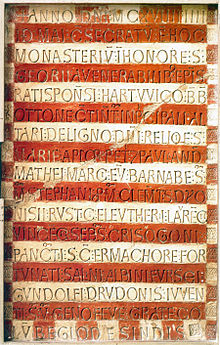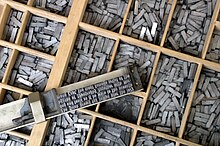Letterpress process


The high pressure is the oldest printing process . The classic process, which is attributed to Johannes Gutenberg in Europe , is printing with movable type. The printing parts are raised. Only the upstanding lines, ridges or areas of the printing form are printed. It is a direct printing process, i.e. the printing plate gives the color directly to the printing medium, e.g. B. paper. Printing forms are either single letters , cast lines or clichés .
history
One type of letterpress is stamp printing . The first known stamps come from the ancient Orient . In ancient times it was mainly clay or wax into which the stamp molds were pressed. The oldest prints were embossed or blind prints without printing ink. A well-known medieval example of printing in clay is the gilt inscription from 1119.
The art of die cutting and engraving had been known since the 4th century. The Chinese used high pressure as early as the 8th century. The oldest surviving printed book dates from the year 868. It already contained illustrations made in woodcut and a font cut in a wooden block. Johannes Gutenberg invented the printing press and modern letterpress in the 15th century. As a result, the printed book experienced a tremendous boom and spread worldwide. Until the end of the 18th century there were no decisive innovations in this area. Up until the 1970s, letterpress printing was the most important method for making books. Today it plays a subordinate role compared to other printing processes (e.g. offset printing or digital printing ).
Procedure
Letterpress is a mechanical printing process. The printing parts are raised on the print substrate, while the non-printing parts are recessed. Since letterpress is a direct printing process, i.e. the printing form transfers the color directly onto the printing material, the print image on the printing form must be mirror-inverted. The print image is first colored and then pressed against the substrate. Almost all paper and cardboard can be used well.
A distinction is made between several types of printing forms, depending on their nature. Hard high-pressure forms are made of wood, metal, copper, zinc, iron, steel, brass or an alloy of lead, antimony and tin. Due to their high degree of hardness, they also have a high level of resistance. This enables the printing of long runs.
Elastic high pressure forms are made of linoleum and soft and hard rubber. Due to their high elasticity, only small print runs are possible. The plastic pressure carriers are made of plastic, celluloid, cardboard or synthetic resins. The single letters are made of lead ( lead type ), wood or plastic. Clichés are made of zinc or plastic. In order to duplicate clichés cheaply and quickly, stereotypes are made from lead. Clichés made of brass alloys, zinc and steel are used for blind and hot stamping.
The surface finish of the printing plate is just as important for printing. Whether the surface is rough, porous or smooth is determined by the ink absorption during rolling and the ink release during printing. For example, the copper plate gives off much of the paint it has absorbed. The zinc and iron plates, on the other hand, retain a lot of color.
Another print medium is the winding drive that especially in Letterset used method. The winding plate is a flexible photopolymer relief plate on which the printing areas are also raised. The templates here are negative films. In this process, finishing is necessary in order to be able to ensure a uniform transfer of the printing ink onto the printing material. Today this is rarely done by hand, but using a prepared film. The dressing is done chemically.
workflow
First of all, the metal type is set, the clichés are etched or the images are reproduced. After the make-up or the side assembly , the exclusion and the mold assembly are carried out. After the press has been set up and prepared, the colors are set up and the print run is carried out.
features
The print image of the letterpress can be recognized by the concise squashed edges of the letters. Furthermore, shading can be seen on the back of the printed sheet. A slight relief can be felt. With this process, very sharp print images can be produced. Another feature of letterpress printing is that the printing plates are very expensive to produce in contrast to the printing plates used in other printing processes.
application
Today, high pressure is rarely used in its classic form. The printing plates are expensive to manufacture. Equally costly is to set them up as a dressing must be carried out. A lot of space is required to store the set. The letters are bound in the standing sentence and can no longer be used.
Nowadays, print graphics or artistically designed books are no longer produced using traditional letterpress printing. In the artistic field, relief printing processes include woodcuts and wood engravings, as well as linocut . A special type of letterpress is the letterset or indirect letterpress , which is often incorrectly referred to as dry offset. In the case of extensive printing projects, book printing has become too time-consuming and costly in terms of material and has therefore become uneconomical. However, some small print shops still have lead fonts and printing machines to be able to produce death notices quickly, for example. The common saying in print shops “customer sits on the stairs and weeps” has its origin in a death, but meant that the printed matter was needed immediately.
The most important cultural revolution of the last five centuries was letterpress printing. Letterpress is called letterpress because the printing elements are raised. In the last few years, starting around 2015, book printing has even become modern and contemporary again. Traditional letterpress printing has experienced a renaissance in recent years due to the rediscovery of manual or artistic activities. Currently mostly in creative circles and under its English name Letterpress.
Thanks to the relief-like printed image, the art of printing offers striking haptic and visual experiences. In contrast, modern digital and offset printing cannot depict these experiences. Nowadays more pressure is exerted in letterpress than in traditional letterpress printing and this gives a relief-like printed image.
The centuries-old craftsmanship is now used in addition to classic printed products such as business cards, invitation cards or wedding cards for book covers, Christmas cards, postcards, bookmarks, hangtags and many other printed products.
Printing machines

There are different printing machines for the letterpress process:
- Platen printing presses work according to the printing principle face against face, whereby the substrate is pressed with great force against the print carrier. On these small printing machines, prints up to A3 format are possible.
- Stop cylinder high-speed presses enable printing up to a format of 72 × 104 cm. Here the paper is stretched onto a cylinder and rolled over the flat printing medium. A distinction can be made here between one-color and two-color machines. Since only about 5000 prints per hour can be produced, this process is hardly ever used.
- Rotary printing machines work according to the principle of round versus round, that is, the paper runs between the plate cylinder, the printing medium and the impression cylinder and picks up the ink. The perfecting can be done in one pass. In addition, several plate cylinders can be connected one behind the other in such a way that multicolored prints are also possible in one printing process. The printing capacity of this machine is 30,000 prints per hour. Folding and numbering machines are often connected to the machine so that the production process can be further streamlined.
- The Cameron high pressure roller press is a special form of high pressure. Flexible photopolymer plates are attached to two endlessly rotating belts for perfecting . In the first print run, the entire paper web is face-printed. In the second printing cycle, the backprint is carried out. Then the print processing takes place .
See also
- Printing technology
- Letterpress
- One and two-tour machine
- Flexographic printing
- Hand press
- Wooden board printing
- Letterset
- Rotary printing
- Stop cylinder press / high-speed press
- Gravure printing
- Platen pressure / platen press
literature
- Blana, Hubert: The production . Munich: KG Saur, 1998. ISBN 3-598-20067-6
- Bremerfeld, Eckhard; Kapalla, Ralf and Knapp, Holger: Expertise newspaper and magazine publishers. Guide for publishing professions and career changers . 4th edition. Düsseldorf: Springer Verlag, 2001. ISBN 3-935065-03-5
- Laufer, Bernhard: Basic knowledge typesetting printing paper , Düsseldorf: Publishing house booksellers today, 1984. ISBN 3-920514-19-X
- Wolfsturm, Hans-Jürgen and Burkhardt, Hermann: high pressure . Ravensburg: Ravensburger Buchverlag, 1994. ISBN 3-473-48382-6
Web links
Individual evidence
- ↑ Herbert E. Brekle (2005): “Theprüfungingen consecrated inscription from 1119. A paleographic-typographical investigation” [short summary], Scriptorium Verlag für Kultur und Wissenschaft, Regensburg, ISBN 3-937527-06-0
- ↑ Letterpress Manufaktur Hamburg What is letterpress? Printing presses up to 100 years old bring haptic experiences into the present.

